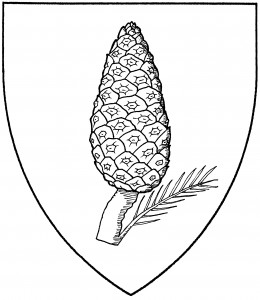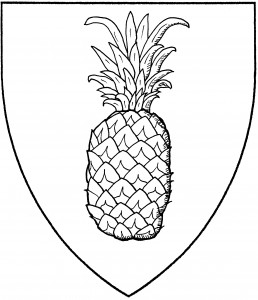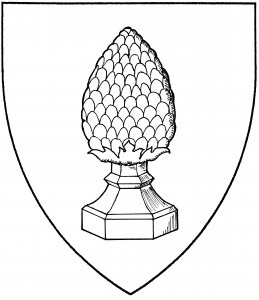A pine cone is the fruit of the pine tree. It is a period charge, found in the canting arms of Pin c.1285 [ANA2 252]; but it seems to have no default orientation, being shown sometimes with the stem up, other times with the stem down. Because of the ambiguity, the pine cone should be explicitly blazoned; the illustration shows a pine cone slipped and leaved, stem to base.
Mundane heralds frequently blazon the pine cone as a “pineapple”. In modern parlance, this is the term for the bromeliadic fruit from South America (or, more recently, from Hawai’i). To avoid confusion, the Society does not use the unmodified term: instead, this fruit is blazoned as a “New World pineapple” in Society heraldry. This fruit has its leaves to chief by default; as New World flora, its use is considered a step from period practice.
A specific stylization of the pine cone is found in the arms of Augsburg as early as c.1450 [Ingeram 52]. This form, said to date from Roman times, is invariably potted (or mounted on a pedestal; sources differ as to which it is) with its stem to base. German sources variously blazon this form as a “Pinienzapfen“, “Zirbelnuß“, or “Stadtpyr” [Leonhard 252]; in the Society, it’s blazoned as a “cedar cone”, to distinguish it from a pine cone. See also hops.
The Shire of Emerald Glen bears: Or, a dragon dormant, tail sufflexed sable within a laurel wreath vert, in chief three cedar cones vert, potted sable.
Morgillian of Greenbough bears: Or, a pine cone, stem to chief vert.
Marsaili inghean Domhnaill bears: Or, a New World pineapple vert, on a chief sable a sun in its splendor Or and a moon in its plenitude argent.


